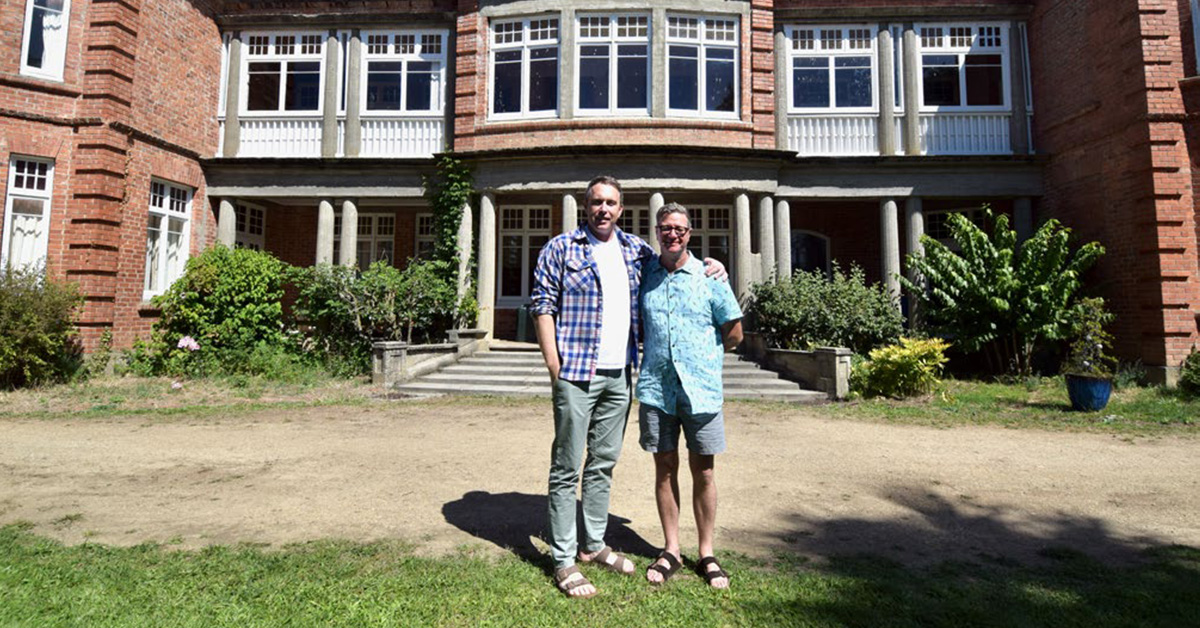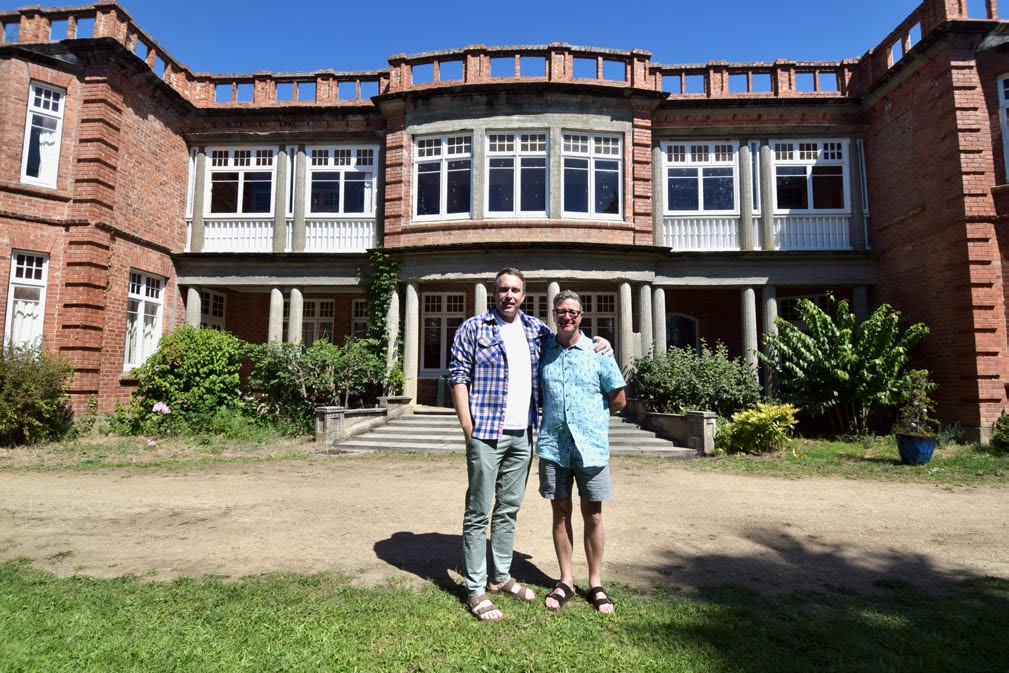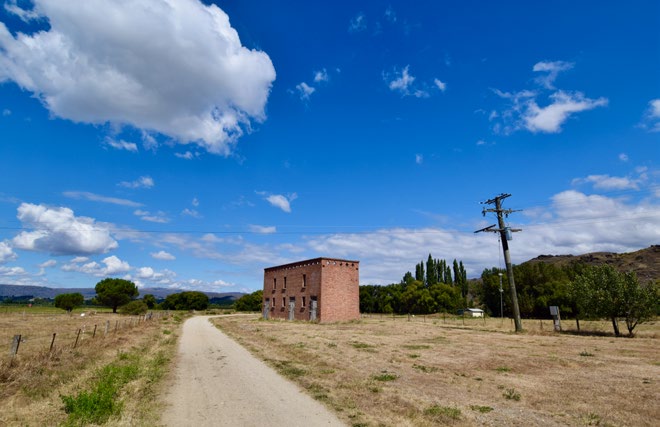
Four Corners
The Castle that Rabbits Built
In 1920, a Central Otago farmer began building a red brick “castle,” funded by the meat and skins from the pests on his land. More than a century later, two Aucklanders are trying to finish the job — if they can get permission.
It sounds like it was a wasteland. When Stephen Spain took on the lease for Earnscleugh Station in 1902, the last leaseholder had walked off the property, abandoning it to the Crown after a bitter winter took out half his flock and rabbits had grazed the land bare. But Spain must have thought he could make a go of it. In less than 20 years, the rabbits would make him a fortune.
The 10,000-hectare property is in one of the harshest environments in the country, rising from the dry river flats bordering the Clutha River, to the 1682-metre summit of the Old Man Range, a slumping hulk of schist eroded into enormous wind-scaped tors. According to Māori mythology, these rock towers are the frozen remains of a slain man-eating giant, Kopuwai, and his two-headed hunting hounds.
There’s plenty of local yarns swirling around Earnscleugh still. “You get a lot of stories,” says Marco Creemers, one of the new owners of Earnscleugh castle, the grand homestead which stands on part of the station. “And a lot of different versions of the same story, and you’re never quite sure what’s true.”
Back in the 1860s, Central Otago’s first European settlers brought sheep, then rabbits. Alfred Strode was the first run-holder at Earnscleugh, a veteran of the Wellington Militia fighting in the Hutt Valley and Whanganui in the 1840s who later became police magistrate of Otago. He took on the farm’s lease in 1862, just months before the Central Otago gold rush began, which probably proved a bigger boon than sheep’s wool or meat.
The station was managed by William Fraser, a 22-year-old Scotsman who later married Strode’s daughter, Ellen, became a partner in the farm and went on to become a government minister and knight of the realm.
It was Fraser’s idea to bring in the bunnies. He’s believed to have been the first to release rabbits in Otago in the 1860s. Initially they were a protected species — Fraser apparently prosecuted a poacher for shooting rabbits on the property. In a little over a decade, he was paying shepherds to shoot them and released ferrets to keep them in check.
Fraser inherited the station from his father-in-law and sold it in 1893 after being elected to parliament, later serving as Minister of Public Works in William Massey’s government. The new owner, a WS Laidlaw, didn’t last long. The winter of 1895, one of the harshest the country had ever seen, killed off half the station’s flock — and almost a million sheep throughout New Zealand. The rabbits left little feed to help the flock recover and Laidlaw surrendered the lease in 1898. He had been reportedly “reduced from a wealthy man to a near-penniless one”.
Then came Stephen Spain. According to a Heritage New Zealand report, Spain was “born in a tent on the banks of the Clutha River” near Roxburgh in 1862, the year of the gold rush, grew up in Ophir and went on to become a butcher and a baker in Alexandra.
Papers Past reveals he had been in some strife. He features relatively regularly in the court news. He was charged with not paying his Otago Daily Times subscription in 1893, he defaulted on a cheque in 1894, and was charged with “allowing pigs to wander in a public place” in Alexandra the same year. Then he faced bankruptcy proceedings in 1895.
Somehow, by 1902, he had got enough money together to take on the lease at Earnscleugh. At first it seems the rabbits were more profitable than the sheep. One source claims he employed 32 men for five months, killing a not-inconsiderable 250,000 rabbits.
Spain used the profit from selling rabbit skins to buy stock and was regarded in the district as “a rabbit farmer.” But within five years, The Press reported he was shearing a flock of over 12,000 sheep.
Soon the rabbits began showing their worth. During World War I, Spain started a factory in an old brewery in Alexandra canning rabbit meat for the war effort. Local records show the factory employed 90 people at its peak, mostly exporting the meat to Britain and the United States. Under a lucrative contract with the British War Office, the two-pound cans sold for $82.69 each in today’s money. The factory could process up to 15,000 rabbits a day, producing 24,000 cans. The skins weren’t wasted either: they sold for £1 per pound.
There may have been some subterfuge in this success. Local records claim the cans were mislabelled as “chicken”, and a Heritage New Zealand report said “according to rumour” shipments destined for France were labelled “poulet”.
By 1919, Spain had amassed a fortune worthy of a castle. He commissioned Edmund Anscombe, one of the top architects of the time, to design a 21-room manor, complete with servants’ quarters, stables for his racehorses and a coach house. Anscombe had designed some of Dunedin’s most notable and grandiose buildings, including Otago Girls High School (1910 and 1921), and parts of the iconic University of Otago clocktower block and the Haynes’ Building (1914) on Princes St, now known as the Savoy. He went on to design the buildings in the grandiose 1939 Centennial Exhibition and later designed the Post and Telegraph building on Wellington’s waterfront.
The castle was built in the early 1920s, a red brick “Jacobethan” building — a combination of Jacobean and Elizabethan styles popular in England and the United States at the time. Heritage New Zealand calls it an “eccentric design” and “a tangible manifestation of that tendency of New Zealand runholders to indulge in displays of conspicuous consumption”.
But the building was never completed. Anscombe’s designs show it with a plastered façade covering much of the brick work and the concrete pillars. Spain ran out of money. Britain’s market was flooded with canned meat in the 1920s and the rabbit-canning factory closed in 1924. The subsequent Great Depression also hit Spain’s investments, and rabbits abounded at Earnscleugh again.
The castle became known locally as “Spain’s Folly” for its eyewatering cost (close to $1 million in today’s money) and the fact it was built on Crown-owned leasehold land meaning he was unlikely to be compensated for the manor if he sold the lease or if it wasn’t renewed.
Spain died in 1940. The building stayed in the family, but a feud saw it literally divided down the middle. A brick wall was built down the centre and out into the garden to separate the families of the two siblings living there. The saga was alluded to in the 1969 memoir Castle on the Run, written by Spain’s granddaughter Gay McInnes, who grew up in the castle in the 1930s.
The Spains sold the castle in 1948. The lease was taken on by a couple of farming and orcharding families. It was freeholded in 1996 and was put on the market last year. Now, new owners have come to Earnscleugh.

If permission is granted, restoration of the castle is expected to take 18 months and finish a project 100 years in the making. Photo: George Driver
Marco Creemers and Ryan Sanders were living in an Auckland apartment, thinking of a life in the country when they learned the castle was for sale. Sanders emailed the listing to his husband, Creemers, saying “stuff it, we’ll live here”.
They’re not exactly this-could-be-us Escape to the Chateau dreamers — they have both property experience and the funds to bring Earnscleugh back to glory. Creemers has been general manager and projects director for 32 years for the Friedlander family’s Samson Corporation, one of the largest commercial property owners in Auckland, with a portfolio that includes a fair number of heritage buildings. Starting as a labourer in the company, Creemers is cited as one of the most influential figures in the city’s real estate scene.
Sanders grew up in Canterbury and began his career as a professional rugby player, playing for Scottish clubs in the early 2000s. He went on to work in recruitment for a banking firm there, when he realised New Zealand was becoming a bucket-list tourism destination. He put his life savings into starting a tourism business, Haka Tours, in 2007, getting a head start on the tourism boom of the 2010s. In 2019, Deloitte named Haka Tourism Group New Zealand’s fastest-growing tourism brand. It now has a portfolio that includes a network of backpacker accommodation under the brand Haka Lodges that employs 190 staff.
Sanders and Creemers flew south for a visit to Earnscleugh on a rainy day in March last year. When they first saw the imposing brick facade, after bumping over rain-filled potholes down the long, unsealed drive, Creemers exclaimed, “Oh my god, we are going to buy this aren’t we?”
The couple bought it for what was reportedly “slightly ahead” of its $8.46 million rateable value, along with 12 hectares split off from Earnscleugh Station (which is still a working property of 21,000 ha).
The couple have ambitious plans to finish off the project Stephen Spain started more than 100 years ago, by finally plastering the brick facade. It’s not only for aesthetic reasons, but for practical reasons, Creemers says. Because it was meant to be plastered, lower-quality bricks were used and the brick mortar was left rough and exposed to weather. Likewise, the windows were left bordered by a small gap to be filled with plaster but now let in drafts and moisture.
Creemers and Sanders were enthusiastic tour hosts when North & South visited. We started in the kitchen. While the exterior of the castle looks regal, the kitchen, on the shady side and at the rear of the building, is more 1950s state house than 1920s château.
During a tour of the 21 rooms, it looked like some hadn’t been lived in for decades. There’s a second kitchen — from when the castle with divided into two homes — like one you’d find out the back of an old rural hall. The roof was severely leaking in one room. Another had a self-resetting rat trap to keep the vermin at bay. Many rooms — particularly those used as the servants’ quarters — were small and pokey. Outside, the pool was empty and dilapidated, with brown puddles in the bottom.
But Creemers and Sanders see potential. “It’s big, but it’s got quite an intimate feel,” Creemers says. “It’s all only one room deep, so you’re always quite connected with everything.”
If it was built anywhere else, Creemers says, the building would probably be beyond repair. Fortunately, Central Otago gets about a quarter of the rainfall of Auckland so dampness has not been a significant issue. Most of the repairs required are superficial. However, it needs earthquake strengthening to bring it up to code. The couple hope this can be incorporated into the proposed plaster work, which will cover much of the facade.
The work has hit its own brick wall, though. Because it has a category-one heritage listing, plastering the building requires council approval, and the Central Otago District Council has said no. Heritage New Zealand has supported the planned restoration, saying the strengthening of the building mitigates the impact on the heritage values. But a council consultant said the plan to plaster the building will have a “more than minor” impact on its heritage values. The consent has been notified.
If the plastering is not approved, Creemers says it will cost significantly more to earthquake strengthen the building and require more obtrusive internal structures, also impacting the heritage values.
While they wait on the outcome of the public notification over the plastering, they are renovating the old coach house, a single-storey brick building, built in the same style as the castle, about 30 metres behind the main building. This will be their home base during the restoration, which Creemers will oversee full time having left Samson Group in April. The stables, meanwhile, will be turned into an art gallery and studio. The couple’s plans also included removing internal walls to make larger rooms in the main house, and raising the ceiling above the central staircase to allow for an ornate chandelier. This work has already been approved. The restoration is being designed by RTA Studio, architects recommended by the couple’s new neighbour, Sam Neill.
Eventually Creemers and Sanders plan to live in the castle, running it as a bed and breakfast. Sanders will continue to manage his multi-million dollar tourism business from the castle.
They’ve also been getting to know the past residents, including Gay McInnes, Spain’s now 86-yearold granddaughter, who lived in the house when it was split in two. And they’ve learned the building may be haunted. One of their local builders won’t enter the place because of the bad vibes. Then the carpet layer told them about the murder. In the 1970s, a former resident killed his wife’s lover, the local policeman.
“We’ve met all three of the families that have lived here for a long time,” Sanders says. All have information that is helping them understand the layered history of both the castle and its inhabitants over the decades and to look forward to the castle having another century of stories to tell.

George Driver’s role is made possible by support from NZ On Air’s Public Interest Journalism.

This story appeared in the May 2023 issue of North & South.


